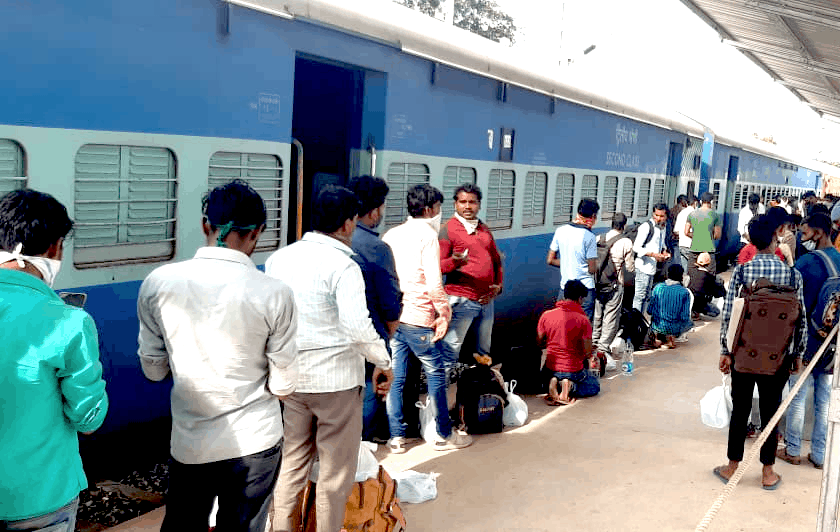In the concluding part of this two-part series, we look at what prevented builders and the government from rushing to the aid of construction labourers during the lockdown. In Part 1 ‘Why Bhuvilal Mahato stayed back in Bengaluru’ we saw how migrant workers who were looked after by their employers, did not feel the need to leave the city.
For migrant workers in Bengaluru, the promise of deliverance after a traumatic locked down lasted briefly. No sooner did Chief Minister B S Yediyurappa announce shramik special trains to ferry them back to their States, the Confederation of Real Estate Developers’ Association of India prevailed upon him to reverse the decision.
Construction activity had just been struck off the list of don’ts in Lockdown 3.0, beginning May 4. All but forgotten for over 40 days, workers, much as they wanted to go back to their families, were left with no means of transport.
The public outrage against the CM’s decision was immense. Social media showed workers trying to walk thousands of kilometres to their homes. Some who approached police stations to apply for passage were lathi charged.
Trains have resumed since, thanks to the public backlash, but the process of applying, paying and waiting for their turn for a ride back home seems to be as dehumanising as the lockdown was for them.
The reasons for a large number of workers wanting to leave even though construction activity has resumed, are many: they range from emotional reasons to downright existential issues like lack of food, money, care and a sense of abandonment.
Senthil S, a Corona Volunteer who helped many construction workers during the lockdown, says that most workers who want to leave are those who have not been taken care of by the builder/contractor/government, and those who are bachelors. “They have no family members or support system here. They have no money, no food, and are worried that if something happens to them, they will die alone.”
A small number of workers who worked for big builders were looked after by their employers, he points out. “Even there, they usually give money for sustenance only, just so that the worker can return to work post-lockdown. For example, if the worker’s wage is Rs 600 per day, the contractor would give him Rs 600 per week.”
Bobby Reddy, a CREDAI member who attended the meeting with Yediyurappa, says that builders affiliated with CREDAI had paid, on an average, 25% of the usual wage to their workers. Only about half the builders in Bengaluru are affiliated with CREDAI, he pointed out. Asked why full wages were not disbursed, he said builders had to bear the cost of rations for the workers besides paying for the maintenance of labour colonies.
Not all big builders went to their workers’ rescue either. Anil Kumar, a labour contractor with an established company, pointed to two reputed builders, his company’s clients, who did not care. He rationalises it thus: “Builders can’t be expected to pay full wages, but should at least ensure food. We paid the workers Rs 1,000 a week. The two builders have not paid us yet. They collected workers’ data, including their Aadhar numbers, and told us that they’ll settle some amount if workers return to work.”
There are also many reports of contractors pressuring workers to return to work. Some even ordered workers out of labour camps when they didn’t comply.
Where does the buck stop?
Praveen Subrahmanyam, Associate Director at Knight Frank, pegged labour costs in real estate projects in Bengaluru at around 35-45%. He believes that although the cost is high, builders could have borne this cost during the 1-2 months of lockdown.
“Most construction sites, especially of big builders, already opened last week, and smaller ones are also likely to start soon. Assuming the lockdown will end this month, the mid-to-luxury segment of real estate may face a slump that could last 6-9 months, mostly because people won’t go out to look at properties. The mid-to-lower and affordable housing segments – which come to 20-25% of the market – will be affected more as sales may plummet. Only this segment of builders may delay starting work due to fund crunch,” says he.

“There were builders who wanted to help workers but didn’t know how to; those who did not help due to resource crunch; and those who did not want to help at all” – Praveen Subrahmanyam
Praveen, who volunteered in relief work during the lockdown, believes that the contract system has immunised builders from the plight of the workers. Due to the disconnect, the former had no data on the latter. “They didn’t know where to find workers,” he points out, adding that workers who lived in labour camps were better off than those who lived dispersed in rented accommodations. There was mistrust too: Builders were not sure that contractors would pass on full wages to the workers if they gave them full payment, he reveals.
Bobby says it took CREDAI 3-4 weeks to compile granular data of workers. “In the initial weeks of the lockdown, only contractors used to deal with workers. What we learnt is that builders should have a direct connect with workers; we can’t rely on contractors alone. We need to have granular data and better records of labourers.”
Clearly, the employers — big or small — have several justifications to deflect blame, especially with the benefit of hindsight. The builders blame the contractors and vice-versa. Ultimately it is the worker who is left in the lurch. The lack of a pro-active relief programme by the State only increased the workers’ misery.
Will the government please stand up?
Three of the workers I spoke to – Ramchandra, Rajiv and Bhuvilal Mahto – were completely unaware that there exists a government-announced cash relief of Rs 2000 (now enhanced to Rs 5000) for construction workers. None of them had registered with the Karnataka Building and Other Construction Workers Welfare Board.
Not that the announcement would have benefited many migrant workers in the city. According to a May 9 report in the Times of India, Labour Minister Shivaram Hebbar clarified that only registered workers were eligible for this amount. The same report notes that of the 15.8 lakh registered construction workers across Karnataka, only 15% – around 2.3 lakh – are migrants.
Food relief was patchy as well. The minister himself says that lunch and dinner had been supplied to about 1.4 lakh workers overall (not construction workers specifically), and that ration kits were given to three lakh.
This means only a small proportion of construction workers were covered in these efforts. Hebbar says, “The Labour Department didn’t know where the workers were, we just didn’t have the data. This has been the case with Labour Departments across the country and not just Karnataka.”
He further says, “We have learned our lessons from COVID – that we need to have workers’ data. We also need to ensure better compliance from employers. Contractors have long behaved as if the Labour Department doesn’t exist.”
Now, who’s panicking?
Rumours and panic, along with poor communication from the government, promoted workers to leave, says Reddy. While that may be partly true, it is clear that the builders too are very worried, seeing the hoards of homeward-bound labourers.
“Labour is our lifeline. New workers may come in later, but they will have to be skilled all over again which will raise our costs,” he says.

Praveen of Knight Frank argues that such fears on the part of builders is largely unfounded. Builders do not require as much labour at the moment, he says. “Every year, migrant labour is not usually available in May as they return to their villages in the sowing season. And from June to September, construction slows down in Bengaluru due to monsoons.”
Zia Nomani, a member of Swaraj Abhiyan who has been helping migrant workers, says they shift from seasonal agricultural work in rural areas to non-farm manual work in cities during the lean season. “This is the season when these workers return to their farmlands for post-harvest agricultural activities. They usually sow rice seeds in this season. This is a year-on-year trend, and you cannot stop their movement as it would impact food availability to their families and the food supply chain in the long run.”